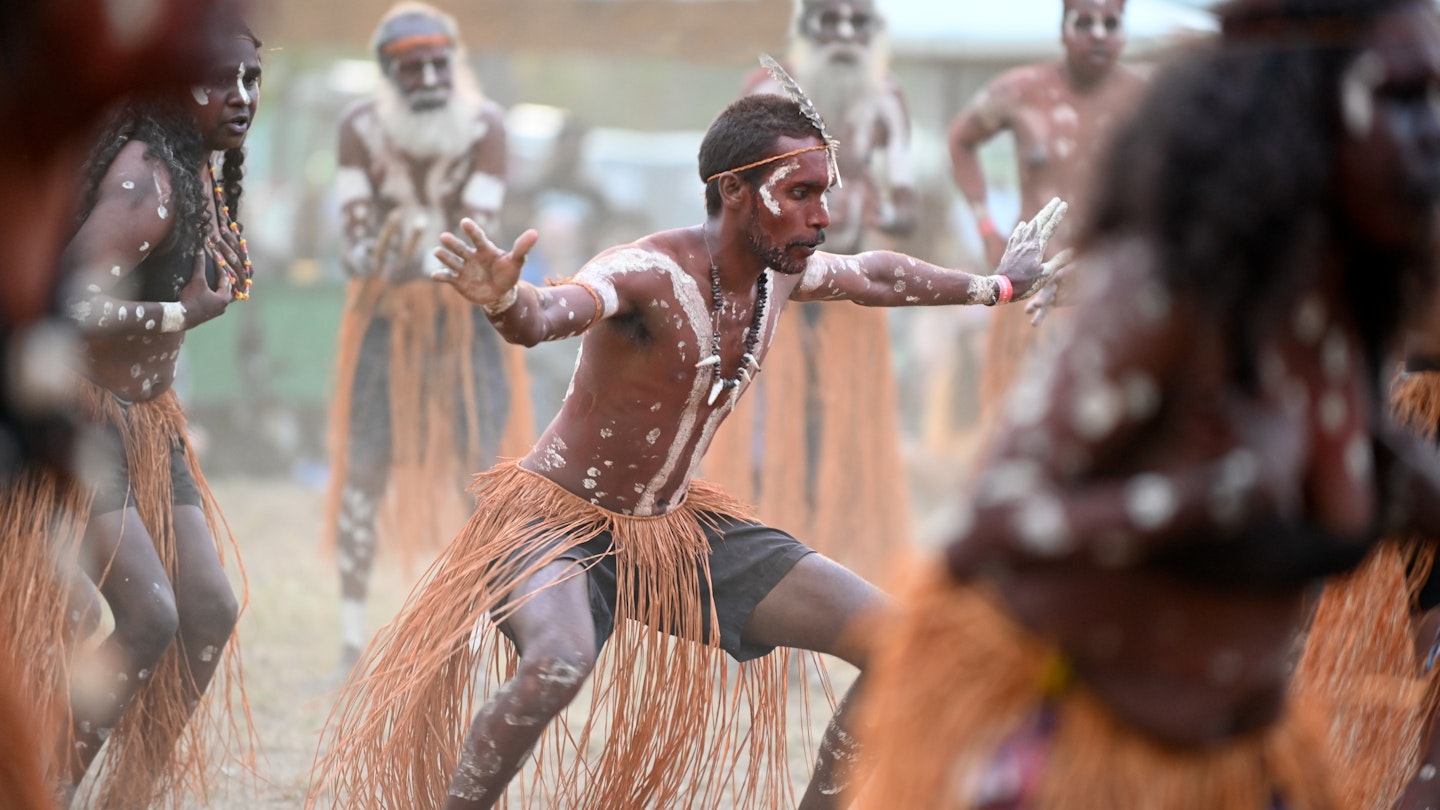
“The rainforest is like our supermarket, but we have to be careful which aisle we shop in,” chuckles Kuku Yalanji man Levi Williams, who guides visitors on cultural walks at Mossman Gorge in Queensland’s ancient Daintree Rainforest. “These things are toxic enough to kill a person within hours,” he explains, pointing to a cassowary plum on the forest floor that can only be safely ingested by the flightless bird that gave the vivid blue fruit its name.
With over 65,000 years of ancestral knowledge, Aboriginal and Torres Strait Islander guides are not only experts at interpreting Australia’s wild and beautiful landscapes but also master storytellers, each holding a unique connection to their traditional lands. Guided tours are just one of many pathways to connect with the world’s oldest living cultures. Below is your guide to unforgettable Indigenous tourism experiences in Australia.

Who are the Indigenous Australians?
Australia’s Indigenous peoples consist of two distinct cultural groups: the Aboriginal peoples of mainland Australia (and Tasmania) and Torres Strait Islander peoples from the Queensland archipelago. There are several hundred groups within these cultures, each possessing their own customs, languages, and laws. Language groups are often referred to as “Nations,” with groups within Nations described as “clans” or “mobs.”
Terms such as “Aboriginal,” “Indigenous,” and “First Nations” are commonly used to refer to these cultures collectively, although preferences for terminology can vary among different groups and individuals. Therefore, when in doubt, it is best to ask.
Understanding Indigenous Cultures in Australia
The cultures of Aboriginal and Torres Strait Islander peoples are diverse, yet they all share a deep connection to family, community, Country (referring to traditional lands), and spiritual beliefs. The concept of The Dreaming (or Dreamtime) illustrates the intricate network of Indigenous spiritual beliefs.
Despite the ravaging impacts of colonization, many Indigenous languages and traditions have been lost, yet the resilience of Australia’s Indigenous cultures remains strong. Darren “Capes” Capewell, a descendant of the Nhanda people, highlights that “Aboriginal culture isn’t dead; it has just been sleeping in some places.” His tours emphasize the importance of preserving local Indigenous names for plants, animals, and landscapes to safeguard ancestral languages.

Experiencing Aboriginal Culture
While Aboriginal and Torres Strait Islander peoples make up less than 4% of Australia’s population, Indigenous culture is prevalent throughout the country.
Each corner of Australia, including its coastal regions, lies within the traditional lands of an Indigenous group known as the Traditional Custodians or Owners of that lands. Many towns and cities feature cultural centers, museums, or art centers where visitors can learn about the Traditional Custodians of the specific area they are visiting.
Indigenous guided tours are available across Australia, from remote national parks to urban environments. These experiences cater to various audiences, including families, seniors, and those with disabilities. Such unique offerings help deepen understanding and appreciation of Indigenous heritage.
What Happens on an Aboriginal Tour?
Indigenous tourism continues to evolve over time. Traditionally, observances might have included mock ceremonies or attempts at throwing a boomerang. However, modern experiences now offer diverse and meaningful ways to appreciate Indigenous cultures.
Many tours are structured as family-friendly walking adventures featuring storytelling and opportunities to sample bush foods. In northern Australia, male visitors may learn how to produce a unique sound on the didgeridoo, a wind instrument traditionally not played by women.
For those seeking adventure, consider scaling the iconic Sydney Harbour Bridge with a First Nations storyteller or embarking on a cruise of the Great Barrier Reef with Indigenous guides who offer a fresh perspective on this natural wonder. Additionally, opportunities to create art with local Indigenous artists provide deeper cultural engagement.
Engaging in multiple Indigenous experiences can offer richer insights, and choosing experiences run by Indigenous operators ensures that tourism dollars directly support Indigenous communities.
Visiting Aboriginal Communities in Australia
Many Indigenous Australians choose to reside on the traditional lands of their ancestors, keeping cultural connections alive. However, a permit might be required for visits to certain Indigenous communities, particularly in remote areas, to ensure cultural respect and safety.
It is generally considerate to wear modest clothing covering shoulders and knees when visiting Indigenous communities, and photography rules vary. Having patience and respect for cultural norms enhances the quality of interactions.

Etiquette for Visiting Sacred Sites
Sacred sites are significant to all Indigenous groups, ranging from natural formations, like Uluru, to historical artifacts and cultural landscapes. Appropriate dress and conforming to specified cultural cues is essential.
Visitors are advised to avoid climbing sacred sites in respect of Indigenous traditions. Many locations, such as Uluru and several mountain ranges, are officially closed to hikes.
Where to See and Buy Aboriginal Art
Indigenous art can be found in rock-art sites and contemporary galleries throughout Australia. One of the best ways to purchase ethically sourced art is through Indigenous art centers, where visitors can often meet artists and participate in workshops.
Best Indigenous Festivals
Experiencing Indigenous festivals is a vibrant way to connect with Aboriginal and Torres Strait Islander cultures. Notable festivals include Yabun Festival, Yirramboi Festival, Garma Festival, Barunga Festival, and the Laura Quinkan Dance Festival. These events often feature Indigenous art for sale, providing exceptional opportunities to support local artists and communities.





